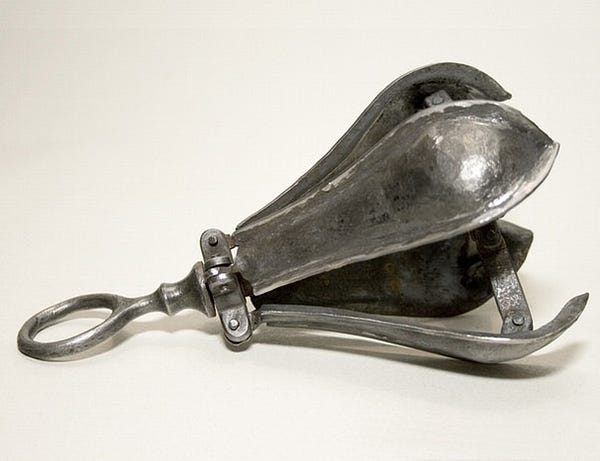 The pear of anguish or gag pear is the present day name for a kind of instrument showed in a few historical centers, comprising of a metal body (generally pear-molded) partitioned into spoon-like fragments that could be spread separated by turning a screw. The exhibition hall depictions and some late sources attest that the gadgets were utilized either as a stifler, to keep individuals from talking, or inside as an instrument of torment.The choke pear (or pear of anguish) is the modern name for a type of instrument displayed in some museums, consisting of a metal body (usually pear-shaped) divided into spoon-like segments that could be spread apart by turning a screw. The museum descriptions and some recent sources assert that the devices were used either as a gag, to prevent people from speaking, or internally as an instrument of torture.There is no contemporary first-hand account of these devices or their use. However, through the design of the devices, such as metal consistency and style, these are often dated to the early modern period (circa 1600). An early mention is in F. de Calvi's L'Inventaire général de l'histoire des larrons ("General inventory of the history of thieves"), written in 1639, which attributes the invention to a robber named Capitaine Gaucherou de Palioly in the days of Henry of Navarre. Palioly would have used a mechanical gag to subdue a wealthy Parisian while he and his accomplices robbed the victim's home.
The pear of anguish or gag pear is the present day name for a kind of instrument showed in a few historical centers, comprising of a metal body (generally pear-molded) partitioned into spoon-like fragments that could be spread separated by turning a screw. The exhibition hall depictions and some late sources attest that the gadgets were utilized either as a stifler, to keep individuals from talking, or inside as an instrument of torment.The choke pear (or pear of anguish) is the modern name for a type of instrument displayed in some museums, consisting of a metal body (usually pear-shaped) divided into spoon-like segments that could be spread apart by turning a screw. The museum descriptions and some recent sources assert that the devices were used either as a gag, to prevent people from speaking, or internally as an instrument of torture.There is no contemporary first-hand account of these devices or their use. However, through the design of the devices, such as metal consistency and style, these are often dated to the early modern period (circa 1600). An early mention is in F. de Calvi's L'Inventaire général de l'histoire des larrons ("General inventory of the history of thieves"), written in 1639, which attributes the invention to a robber named Capitaine Gaucherou de Palioly in the days of Henry of Navarre. Palioly would have used a mechanical gag to subdue a wealthy Parisian while he and his accomplices robbed the victim's home.Thursday, 21 January 2016
PEAR OF ANGUISH/CHOKE PEAR
 The pear of anguish or gag pear is the present day name for a kind of instrument showed in a few historical centers, comprising of a metal body (generally pear-molded) partitioned into spoon-like fragments that could be spread separated by turning a screw. The exhibition hall depictions and some late sources attest that the gadgets were utilized either as a stifler, to keep individuals from talking, or inside as an instrument of torment.The choke pear (or pear of anguish) is the modern name for a type of instrument displayed in some museums, consisting of a metal body (usually pear-shaped) divided into spoon-like segments that could be spread apart by turning a screw. The museum descriptions and some recent sources assert that the devices were used either as a gag, to prevent people from speaking, or internally as an instrument of torture.There is no contemporary first-hand account of these devices or their use. However, through the design of the devices, such as metal consistency and style, these are often dated to the early modern period (circa 1600). An early mention is in F. de Calvi's L'Inventaire général de l'histoire des larrons ("General inventory of the history of thieves"), written in 1639, which attributes the invention to a robber named Capitaine Gaucherou de Palioly in the days of Henry of Navarre. Palioly would have used a mechanical gag to subdue a wealthy Parisian while he and his accomplices robbed the victim's home.
The pear of anguish or gag pear is the present day name for a kind of instrument showed in a few historical centers, comprising of a metal body (generally pear-molded) partitioned into spoon-like fragments that could be spread separated by turning a screw. The exhibition hall depictions and some late sources attest that the gadgets were utilized either as a stifler, to keep individuals from talking, or inside as an instrument of torment.The choke pear (or pear of anguish) is the modern name for a type of instrument displayed in some museums, consisting of a metal body (usually pear-shaped) divided into spoon-like segments that could be spread apart by turning a screw. The museum descriptions and some recent sources assert that the devices were used either as a gag, to prevent people from speaking, or internally as an instrument of torture.There is no contemporary first-hand account of these devices or their use. However, through the design of the devices, such as metal consistency and style, these are often dated to the early modern period (circa 1600). An early mention is in F. de Calvi's L'Inventaire général de l'histoire des larrons ("General inventory of the history of thieves"), written in 1639, which attributes the invention to a robber named Capitaine Gaucherou de Palioly in the days of Henry of Navarre. Palioly would have used a mechanical gag to subdue a wealthy Parisian while he and his accomplices robbed the victim's home.
Subscribe to:
Post Comments (Atom)
No comments:
Post a Comment